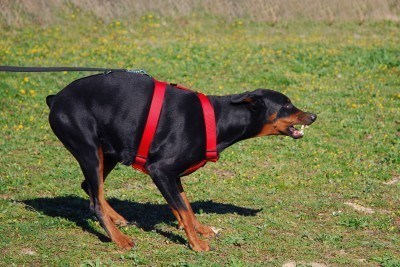
Does your dog bark or growl and lunge at other dogs while you’re walking him on a leash?
This is a very common problem in under-socialized, nervous or anxious dogs. Immediately when your dog sees another dog and barks, he gets an adrenaline reward. Not only are bark-and-lunge explosions stressful for you, but also for your dog. In addition, from your dog’s point of view the aggressive display seems to work pretty well–after all, the other dog always goes away.
That means every time your dog blows up, he becomes a little likelier to try the same tactic next time. So until you can get good professional help, keep your dog out of trouble as much as you can. Dogs have but two options. Flight or Fight: Flight is to run away or avoid, but this isn’t an option when on lead. So the only option left is to fight, by barking and acting aggressively.
It’s best for your dog to avoid encounters altogether by teaching him to ignore other dogs completely when walking on leash, unless specifically stopped on cue, told to sit, and stay and wait for permission to approach and greet. The absolutely more problematic, most difficult way for dogs to meet and greet is on leash.
Once a dog’s mind passes a certain level of arousal, he can’t hear you, everything is oblivious except the other dog. At his peak he may as well be deaf, will not eat treats and does not feel any tugging on the leash. He has become possessed.
He can’t learn a new behavior at his peak of arousal; his learning environment needs to be in your yard absent of any distractions.
If your dog could act naturally and calmly around other dogs he would. But, he must be taught in the quiet of your own home and yard, without distractions. Dogs need active behaviors they can perform in place of their usual bad behavior.
As you begin modifying his behavior, consider the following:
- Treatment depends on how established this problem has become.
- Teaching your dog to focus on you is vital.
- Your dog should learn that when he’s on leash, he should walk past and ignore other dogs. There is no reason to meet and greet.
- Teach a desirable alternate behavior. So it can’t be just the absence of the bad behavior, as dogs don’t understand voids. You need to give him something else to do instead.
- The new behavior must be ingrained into your dog’s head for at least several weeks before expecting him to be able to listen to you in the presence of another dog at a distance.
- Reward the calm before the storm. Reward your dog before the barking starts and he may be able to happily walk past the distraction without reacting at all. By praising quiet, you may avoid noise all together.
- Act the way you want your dog to act. If you want him to be relaxed, calm and happy – move, speak and touch him as if you are relaxed, calm and happy.
- Try a Head Halter. These can be helpful when used properly and make on-leash management much easier on the dog and human. The way to use most head halters is to use a smooth upward pressure to stop forward movement and to help redirect the dog. Release all pressure immediately when the dog sits or calms.
- Don’t set your dog up for failure. If you can avoid a situation that is likely to be a problem, avoid it. Turn around and go a different direction, walk a different route, or walk at a time of day when you won’t encounter your dog’s trigger. Repeating failure won’t help your dog improve.
- Choke collars, pinch collars, and shock collars are designed to stop dogs from barking by causing pain. The dog might stop barking because it hurts, but this won’t decrease the dog’s frustration. In fact, the association with pain can cause the dog to DISLIKE other dogs and ultimately behave AGGRESSIVELY toward other dogs.
With patience, redirection, and praise, your dog can learn how to act appropriately when encountering other dogs during his walk.



